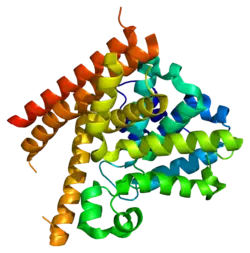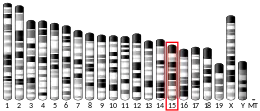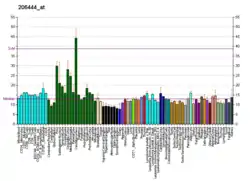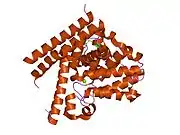PDE1B
Calcium/calmodulin-dependent 3',5'-cyclic nucleotide phosphodiesterase 1B is an enzyme that in humans is encoded by the PDE1B gene.[5][6][7]
References
- GRCh38: Ensembl release 89: ENSG00000123360 - Ensembl, May 2017
- GRCm38: Ensembl release 89: ENSMUSG00000022489 - Ensembl, May 2017
- "Human PubMed Reference:". National Center for Biotechnology Information, U.S. National Library of Medicine.
- "Mouse PubMed Reference:". National Center for Biotechnology Information, U.S. National Library of Medicine.
- Jiang X, Li J, Paskind M, Epstein PM (Nov 1996). "Inhibition of calmodulin-dependent phosphodiesterase induces apoptosis in human leukemic cells". Proc Natl Acad Sci U S A. 93 (20): 11236–41. doi:10.1073/pnas.93.20.11236. PMC 1074519. PMID 8855339.
- Yu J, Wolda SL, Frazier AL, Florio VA, Martins TJ, Snyder PB, Harris EA, McCaw KN, Farrell CA, Steiner B, Bentley JK, Beavo JA, Ferguson K, Gelinas R (Feb 1998). "Identification and characterisation of a human calmodulin-stimulated phosphodiesterase PDE1B1". Cell Signal. 9 (7): 519–29. doi:10.1016/S0898-6568(97)00046-6. PMID 9419816.
- "Entrez Gene: PDE1B phosphodiesterase 1B, calmodulin-dependent".
Further reading
- Repaske DR, Swinnen JV, Jin SL, et al. (1992). "A polymerase chain reaction strategy to identify and clone cyclic nucleotide phosphodiesterase cDNAs. Molecular cloning of the cDNA encoding the 63-kDa calmodulin-dependent phosphodiesterase". J. Biol. Chem. 267 (26): 18683–8. PMID 1326532.
- Spence S, Rena G, Sullivan M, et al. (1997). "Receptor-mediated stimulation of lipid signalling pathways in CHO cells elicits the rapid transient induction of the PDE1B isoform of Ca2+/calmodulin-stimulated cAMP phosphodiesterase". Biochem. J. 321 ( Pt 1) (Pt 1): 157–63. doi:10.1042/bj3210157. PMC 1218050. PMID 9003415.
- Zauli G, Milani D, Mirandola P, et al. (2001). "HIV-1 Tat protein down-regulates CREB transcription factor expression in PC12 neuronal cells through a phosphatidylinositol 3-kinase/AKT/cyclic nucleoside phosphodiesterase pathway". FASEB J. 15 (2): 483–91. doi:10.1096/fj.00-0354com. PMID 11156964. S2CID 26315564.
- Fidock M, Miller M, Lanfear J (2002). "Isolation and differential tissue distribution of two human cDNAs encoding PDE1 splice variants". Cell. Signal. 14 (1): 53–60. doi:10.1016/S0898-6568(01)00207-8. PMID 11747989.
- Strausberg RL, Feingold EA, Grouse LH, et al. (2003). "Generation and initial analysis of more than 15,000 full-length human and mouse cDNA sequences". Proc. Natl. Acad. Sci. U.S.A. 99 (26): 16899–903. doi:10.1073/pnas.242603899. PMC 139241. PMID 12477932.
- Ballif BA, Villén J, Beausoleil SA, et al. (2005). "Phosphoproteomic analysis of the developing mouse brain". Mol. Cell. Proteomics. 3 (11): 1093–101. doi:10.1074/mcp.M400085-MCP200. PMID 15345747.
- Gerhard DS, Wagner L, Feingold EA, et al. (2004). "The Status, Quality, and Expansion of the NIH Full-Length cDNA Project: The Mammalian Gene Collection (MGC)". Genome Res. 14 (10B): 2121–7. doi:10.1101/gr.2596504. PMC 528928. PMID 15489334.
- Bender AT, Ostenson CL, Wang EH, Beavo JA (2005). "Selective up-regulation of PDE1B2 upon monocyte-to-macrophage differentiation". Proc. Natl. Acad. Sci. U.S.A. 102 (2): 497–502. doi:10.1073/pnas.0408535102. PMC 544304. PMID 15625104.
- Bender AT, Beavo JA (2006). "PDE1B2 regulates cGMP and a subset of the phenotypic characteristics acquired upon macrophage differentiation from a monocyte". Proc. Natl. Acad. Sci. U.S.A. 103 (2): 460–5. doi:10.1073/pnas.0509972102. PMC 1326187. PMID 16407168.
This article is issued from Wikipedia. The text is licensed under Creative Commons - Attribution - Sharealike. Additional terms may apply for the media files.






